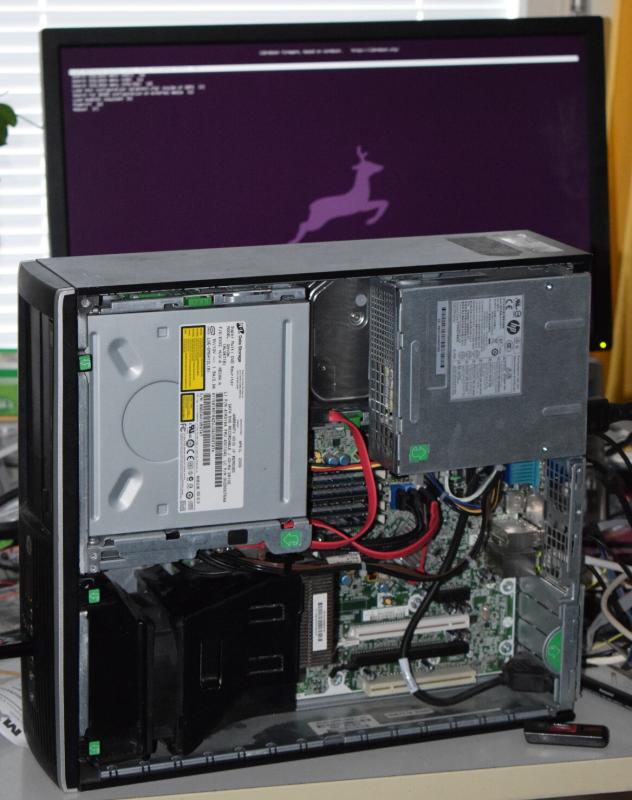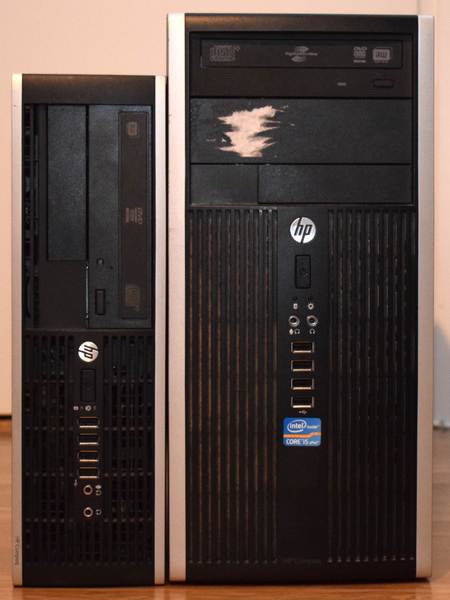8.7 KiB
title: Install Canoeboot on HP Elite 8200 SFF/MT and 6200 Pro Business x-toc-enable: true ...
PLEASE READ THESE INSTRUCTIONS BEFORE INSTALLING, OR YOU MAY BRICK YOUR MACHINE!! - Please click the link and follow the instructions there, before flashing. For posterity, here is the link again.




| Specifications | |
|---|---|
| Manufacturer | HP |
| Name | Compaq 8200 Elite SFF |
| Compaq 8200 Elite MT | |
| Released | 2011 |
| Chipset | Intel Q67 |
| CPU | Intel Sandy/Ivy Bridge |
| Graphics | Intel HD Graphics or PCI-e low profile card |
| Memory | Up to 32GB (4x8GB) |
| Architecture | x86_64 |
| Intel ME/AMD PSP | Present, neutered |
| Flash chip | SOIC-8 8MiB |
W+: Works without vendor firmware;
N: Doesn't work;
W*: Works with vendor firmware;
U: Untested;
P+: Partially works;
P*: Partially works with vendor firmware
| Features | |
|---|---|
| Internal flashing with original boot firmware | N |
| Display (Intel GPU) | W+ |
| Display (PCIe graphics card) | W+ |
| Audio | W+ |
| RAM Init | W+ |
| Payloads supported | |
|---|---|
| GRUB | Works |
| SeaBIOS | Works |
| SeaBIOS with GRUB | Works |
Open source BIOS/UEFI firmware
This document will teach you how to install Canoeboot, on your HP Elite 8200 SFF desktop motherboard. Canoeboot is a Free Software project that replaces proprietary BIOS/UEFI firmware.
Canoeboot has support for this, in the Git repository and release versions from 20230423 onwards.
Brief board info
HP Elite 8200 SFF is a small-form-factor desktop of Intel Sandybridge platform which you can read more about here:
https://support.hp.com/gb-en/product/hp-compaq-8200-elite-small-form-factor-pc/5037931
MT is an identical board with a larger chassis and more powerful power supply:
https://support.hp.com/gb-en/product/hp-compaq-8200-elite-desktop-pc-series/5037940
Here's the Technical Reference Manual. This system supports Ivy Bridge processors too. The original BIOS won't even POST with those, but with Canoeboot they work fully.
Disable security before flashing
Before internal flashing, you must first disable /dev/mem protections. Make
sure to re-enable them after you're finished.
See: Disabling /dev/mem protection
Install Canoeboot
You can actually just compile the Canoeboot ROM for this, and flash the entire ROM.
Internal flashing from OEM BIOS is possible by setting a jumper on the board. Step by step instructions for this are below.
The coreboot project proper has technical details on why this works if you are interested. It also has external flashing instructions if you need to recover from an unbootable BIOS:
https://doc.coreboot.org/mainboard/hp/compaq_8200_sff.html
You can build the images for it in Canoeboot like so:
./mk -b coreboot hp8200sff_8mb
More information about building ROM images can be found in the build guide.
If you plan on using a graphics card (other than the integrated graphics of your CPU), choose one of the files which name contains both "seabios" and "txtmode".
If you are using the Canoeboot ROM images, the ME image is not provided and Canoeboot won't provide it. You avoid a brick by flashing around the existing Intel ME, to avoid a brick. Please read the guide:
How to avoid overwriting Intel ME
You may also wish to change the default MAC address if you're planning to use the onboard Intel Gigabit Ethernet. You can do this using the information in the same guide linked above, or read the nvmutil manual:
Modify MAC addresses with nvmutil.
Internal flashing from vendor BIOS
You can only install with external flashing, when migrating to Canoeboot. Internally flashing Libreboot is possible, from vendor firmware, but that is because Libreboot downloads and inserts all required files including Intel ME, required in this case since you have to shrink the ME region for that method, and Canoeboot cannot (as per its policy include any such files, even indirectly. In Canoeboot, we always flash around what's already there, which means that the full Intel ME is retained (and then disabled during early boot, by modifying the IFD so as to set the HAP bit).
If you have Libreboot, please know as always that the IFD region must not be overwritten. Overwriting the GbE and BIOS regions is OK.
Do not, under any circumstance, overwrite the ME region.
HP 6200 Pro Business PC
According to this page from the vendor, HP BIOS updates are the same on both the 8200 SFF Elite and 6200 Pro Business desktop PCs; therefore, we believe that the Canoeboot config for 8200 SFF will also work on 6200 Pro Business PCs. That page is here: https://support.hp.com/fi-fi/drivers/selfservice/swdetails/hp-compaq-8200-elite-small-form-factor-pc/5037931/swItemId/vc-229778-2
The config for this board is courtesy of Riku Viitanen (Riku_V on Canoeboot
IRC), who tested and confirmed the following functionality:
- Sandy Bridge (i5-2400) and Ivy Bridge (i5-3570S) CPUs
- 4x8 GB RAM (Sandy Bridge: 1333MHz, Ivy Bridge: 1600MHz)
- PS/2 keyboard and mouse
- USB keyboard (a bit laggy on GRUB)
- Boot from USB and DVD
- Gigabit ethernet
- VGA and DisplayPort (Intel graphics), with libgfxinit (native video init)
- Headphone output, PC speaker
- S3 suspend, wake on USB keyboard
- lm_sensors outputs CPU core temperatures only
- Both PCIe x16 slots, external GPU works with SeaBIOS
- PCI
- SATA
- USB ports
- Serial port (RS-232)
- Wake on LAN
At the time of adding this board to Canoeboot, the following is untested:
- Parallel port (internal header on the board)
- Floppy drive. The case has a spot for it, but I can't find the header (P10).
According to the initial coreboot port from 2018, the following also works:
- EHCI debug (not enabled by Canoeboot configs)
- Native (libre) raminit with up to four DIMM modules (also tested by Riku and confirmed working, with 32GB RAM installed as 4x8GB)
TPM
According to git logs, TPM should work, and a commit from 2018 at revision
ID 39d0e2a2cf45e28cdddd0fe0c88f94ce527ab1ef in coreboot makes the TPM visible
to operating systems.
PSU Fan control
See coreboot commit 9bd601584350f51f112b15a7369f9aa82f1d0919 - labelled
by commit message superio/nuvoton/npcd378: Add PSU fan control.
Per this commit, SuperIO-based fan control is supported on HP Elite 8200 SFF.
TODO for testing the above is here:
https://codeberg.org/canoeboot/cbmk/issues/9
This is controlled via nvramtool to modify the value in sram. See:
psu_fan_lvl=3<-- default setting in coreboot, and Canoeboot.
Other values possible: from reading the source code, it is implied that the number can be between 0 and 7. If the value is set higher than 7, it will default back to 3.
Canoeboot locks CMOS/NVRAM settings, but you can change the default setting in
the ROM by using the -C option in nvramtool. You can find this under the
directory src/coreboot/default/util/nvramtool when downloading coreboot inside
of cbmk by running the command:
./mk -f coreboot default
Go in there and type make to build nvramtool. Simply run nvramtool without
arguments, and it will show a list of options.